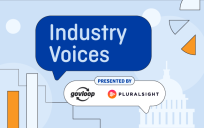Here are some key ideas that are gaining traction as organizations develop initiatives aimed at improving EX.
Moments That Matter
One way to improve EX is to focus on specific “inflection points” in an employee’s work life, writes Gerome Q. Banks, a GovLoop Featured Contributor. The most common such moments include recruiting and hiring, onboarding, training and development, and rewards and recognition.
“Moments that matter will vary significantly based on the business objective, organization and employee,” Banks wrote. “The key is to ensure that the voice of the Federal employee is solicited, heard and taken into consideration when mapping moments that matter and crafting solutions to iterate and scale.”
Employee Personas
The factors that determine an employee’s experience can vary widely across an organization. Nonetheless, an agency can look at employees’ needs as they align with specific demographics, such as age, work experience and job function, notes a blog post on Indeed, a popular job website.
For example, in designing training programs, you might develop one set of modules for entry-level employees and another for those on a management track. Use those same personas to think about other aspects of EX, such as IT requirements.
Employee Value Proposition
Government agencies often struggle to compete with the private sector when it comes to salary. But pay is just one factor that should be considered as part of your organization’s overall employee value proposition (EVP).
The Maryland City/County Management Association, a group of professional local government managers, defines EVP as “the unique set of monetary and nonmonetary rewards and benefits that the organization provides to employees in exchange for their skills, capabilities, commitment, and contributions.”
- Why would a talented professional want to join our organization and stay with us?
- Why would a talented professional be reluctant to join our organization and stay with us?
- What tangible steps could we take so it is more likely that employees will want to join us and stay with us?
The Diversity Wheel

A recent report from the Boston College Center for Work and Family emphasizes the importance of taking a broad view of diversity. One model for doing so is the Diversity Wheel developed by the Johns Hopkins University Diversity Leadership Council.
The center of the wheel represents visible or permanent characteristics, such as gender, race or age, while the outer components reflect dimensions that are not visible or are acquired, such as religion, political beliefs and socioeconomic status.
Generational Differences
Workforce experts say a big shift is coming as organizations begin hiring workers from Gen Z (born between 1997 and 2012). Although generational differences are often overstated, the experts say that Gen Z workers bring subtle but important differences in how they think about work.
According to a study by Gallup, “Gen Z workers and younger millennials are slightly more likely than more senior coworkers to be ambivalent about their workplace.” But they also are less likely to be outright disengaged, so it’s a mixed bag.
A bigger red flag is the risk of burnout.
“Sixty-eight percent of Gen Z and younger millennials report feeling stress a lot of the time,” according to Gallup. “This should concern leaders. Stress and burnout influence job performance and long-term career growth.”
This article appeared in our guide, “Tools and Tactics for Employee Engagement.” For more insights on bringing out the best in your employees, download the guide:





Leave a Reply
You must be logged in to post a comment.